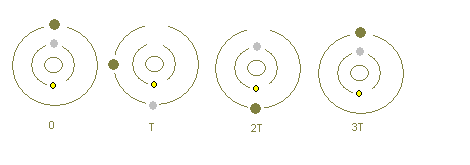
Astronomers have discovered a star system that has five—or possibly six—planets that are in ‘orbital resonance’ with one-another, meaning that the time it takes for any given planet to orbit around its parent star will be a precise multiple (or fraction) of that of the orbit of any of the other planets in the system.
This arrangement represents the longest chain of orbital resonances discovered in an exoplanetary system to date; and offers fresh insights into the orbital mechanics of exoplanetary systems.
This orbital resonance, called a “Laplace Resonance“, initially led astronomers to believe that there were only two exoplanets in TOI-178, since five of the six known bodies would line up to pass in front of their parent star at regular intervals, making them appear to be a single planet. But after more data on the system was gathered, this one planet was instead found to be five.
“Through further observations, we realized that there were not two planets orbiting the star at roughly the same distance from it, but rather multiple planets in a very special configuration,” said lead study author Adrian Leleu, an astrophysicist at the Center for Space and Habitability of the University of Bern.
TOI-178, a K-type star about two-thirds the size of our own, is about 205 light years away in the Sculptor constellation, but is too faint to be seen with the naked eye from Earth. “TOI” comes from “TESS Object of Interest”, with the system having been discovered by the Transiting Exoplanet Survey Satellite, part of NASA’s Explorers program, a mission that watches for the dimming caused by exoplanets as they pass in front of their parent star.
Compared to the bodies in our Solar System, the planets orbiting TOI-178 have very short years, with the sixth planet completing its orbit within 3 Earth weeks. Although the planet closest to the star, TOI-178 b, appears to be out of step with the others, planets “c” through “g” form a chain of resonance that can be expressed as 18:9:6:4:3 in ratios of their orbits. This means that for every eighteen revolutions of planet c, planet d will complete nine, planet e six, planet f four, and planet g three.
Planet b is also not that far from participating in the dance performed by its five sisters: if its 1.91-day orbit was only an hour longer its orbit would resonate with planet c, experiencing five orbits for every three that its neighbor completes. It’s theorized that the planets in TOI-178 formed with their current orbital resonances when the system coalesced from their protoplanetary disk, with planet b having fallen out of step at some point in the system’s history.
This discovery offers a number of insights into the formation and histories of exoplanetary systems. For instance, for the orbits of TOI-178’d planets to be in such close harmony the system probably hasn’t been subject to many disruptive influences, such as large body impacts or migrating planets, quite unlike the unruly orbs found here at home. “The orbits in this system are very well ordered, which tells us that this system has evolved quite gently since its birth,” explains study co-author Yann Alibert, also from the University of Bern.
“The orbital configuration of TOI-178 is too fragile to survive giant impacts, or even significant close encounters… a sudden change in period of one of the planets of less than a few .01 d can render the system chaotic,” according to the study text. This cosmic lockstep is so tenuous “that modifying a single period axis can break the resonant structure of the entire chain,” stressing how uneventful TOI-178’s history must have been.
Curiously, the type of planets found in TOI-178 aren’t delineated like they are in our own Solar System, where the rocky terrestrial planets are found in the inner solar system, while the larger gaseous ones are exclusively outside the asteroid belt. Instead, the arrangement of TOI-178’s planets is mixed, with large, less dense planets being found alongside denser, rocky worlds.
“It appears there is a planet as dense as the Earth right next to a very fluffy planet with half the density of Neptune, followed by a planet with the density of Neptune,” explains study co-author Nathan Hara from the Université de Genève, Switzerland. “It is not what we are used to.”
This finely-tuned harmony throws a monkey wrench into what we know about the formation of star systems and their orbital mechanics, a development that offers new avenues of research for astrophysicists and astronomers. “This contrast between the rhythmic harmony of the orbital motion and the disorderly densities certainly challenges our understanding of the formation and evolution of planetary systems,” according to Leleu.
Subscribers, to watch the subscriber version of the video, first log in then click on Dreamland Subscriber-Only Video Podcast link.
I can accept the possibility of an ancient, highly evolved intelligent species with the know-how of manipulating orbits around stars.